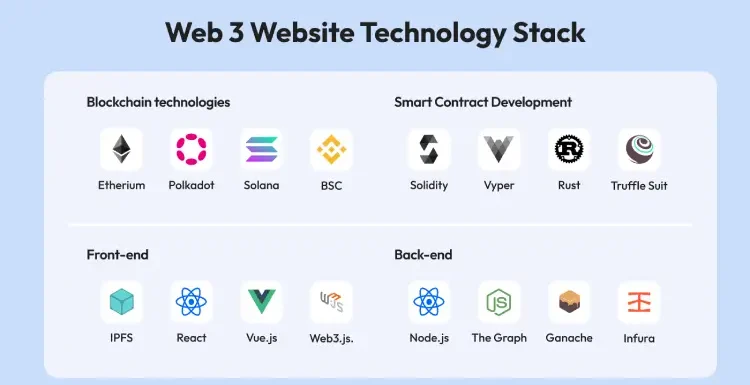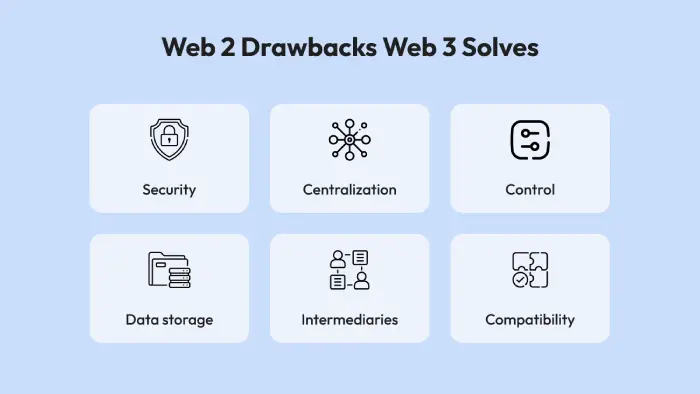
There is a noticeable increase in Web 3 development by 2025. What was merely imagined as future technology just a while back now plays an active role in the internet and is changing how we use it. Everything, including new types of social networks and financial services, is being updated and adjusted. On the other hand, new technologies introduce both helpful and harmful features. This article will focus on what Web 3 development may bring by 2025 and discuss its maximum benefits for everyone involved, as well as the challenges that could arise for consumers, companies, and developers if left unattended.
Why Decentralization Matters
Giving power to individuals, rather than relying on a central agency, is fundamental in Web 3. With the help of blockchain technology in Web 3, dApps can run without using servers and instead use a peer-to-peer system. Now, in finance, customers have the option of transferring funds without banks or other financial experts with the help of DeFi. Some artists are also selling their work as NFTs, connecting one-to-one with buyers. In addition, some communities and projects are now choosing decentralized autonomous organizations (DAOs) because these encourage honesty and consider all opinions when making decisions.
Major Areas in Web 3 Development
There are more changes transforming our interactions with the internet than just development in technology. There are great advantages to this decentralized web such as safe transfers and better access to your data. I will highlight the main potential for building Web 3 in 2025 and how several industries may use it to stimulate growth and development.
Web 3 relies heavily on Blockchain & Smart Contracts.
In 2025, Web 3 will rely on smart contracts and blockchain for its development. A smart contract is an agreement that runs on its own and has all its conditions programmed. When a contract is deployed on a decentralized network like Ethereum, it can no longer be accessed.
Since blockchain ensures everything is visible and safe and secure, it is suitable for supervising the supply chain process in which following all the steps that led to the transport of raw materials is important. Many businesses use blockchain to make sure their diamonds are obtained through ethical means. With blockchain, individuals can check where the diamond was mined and how it was processed.
Further, the nature of Web 3 is paving the way for new business opportunities. With the introduction of dApps, new businesses can make applications that operate by themselves, saving money and avoiding risks linked to failure of a single element. We can use such apps in all aspects of gaming.
Improved control over personal data
Web 3 also gives people the power to manage their information freely. Web 3.0 allows people to keep control over their information on the blockchain, something Web 2.0 firms do not offer, as they collect that data to profit from it.
An example to consider are decentralized social media platforms. To target advertising campaigns, companies collect users’ data and use mainstream sites such as Facebook and Twitter. With systems like Minds and Mastodon, people can keep control of their data. Individuals on these networks can select the people who access their data and can make money off it as well.
It is a game-changer because the topic of privacy in data is more important today. Therefore, giving people more control over their information will create more trust when using the internet because they are learning about the dangers of relying on large internet companies.
Mix and Match Gameplay
By 2025, Web 3 will be known for having various technologies collaborate effectively. As more blockchain platforms appear, there is now a need to bring these into use smoothly. They do not need to go through intermediaries when transferring assets and data due to interoperability.
A person can therefore use one identity in several decentralized applications or move their tokens to different DeFi solutions. Because users will be free to work across systems, a simple Web 3 experience will encourage many to use it.
Interoperability gives enterprises the possibility to design more flexible and expandable solutions. Consider how partners in various blockchain systems could freely and securely share their data and resources. Such a connection would make it possible for Web 3 technologies to reach their full capabilities.
Web 3 Development Challenges
Even while Web 3 may make life easier, some issues remain that everyone needs to be mindful of.

Scalability Problems
It is especially challenging to make Web 3 able to accommodate a growing number of users. Blockchain networks are expected to deal with more data as users and organizations rely on decentralization to minimize risks.
Many networks such as Ethereum, are now seen as having slow and costly transactions. While Ethereum 2.0 and different layer-2 solutions are being made, it is still a big problem. As a result, this makes it challenging for decentralized exchanges or gaming platforms, as they need more transactions to function properly.
Until Web 3 can support a larger number of users, it may not be adopted by many people. To ensure their dApps can expand in the future, developers need to pick the appropriate blockchain networks and technologies.
Problems related to User Experience (UX)
For more people to adopt Web 3, using it should be simple and worry-free. There are many Web 3 applications where individuals have to understand what private keys, cryptocurrency wallets and gas fees mean.
One could accordingly examine how person-to-person transactions are carried out on a decentralized platform. First, users have to create a wallet, then buy some cryptocurrency and lastly, cover the gas fees for all actions. This process may seem challenging for those who do not know much about blockchain technology.
Web 3 should be made simpler for users to draw in a larger audience. For example, you should make it easy for new users to sign up and interact with the blockchain in the same way they can with web-based options.
Regulatory Uncertainty
Since Web 3 is growing, regulators are becoming more involved. Many governments are still working out how best to manage issues arising from these new technologies.
Bitcoin and Ethereum are among cryptocurrencies that others have accused of providing opportunities for money laundering. Furthermore, some are concerned that decentralized finance platforms allow for manipulation and may not be secure, especially if you consider to create an investment platform. Web 3 is difficult to regulate using standard laws since it is decentralized.
Since regulations are still being developed, companies entering Web 3 could run into legal issues. Those who develop software should keep up-to-date with changes in their local regulations and act promptly to ensure they comply.
Security concerns
Blockchain technology is safe, but Web 3 is still vulnerable to cyberattacks. Even though smart contracts and decentralized applications are used, hacks against them have still led to several major attacks in the past.
Last year, Poly Network was hacked for $600 million due to weaknesses in its smart contracts. After the funds were recovered, this situation pointed out the potential threats in developing Web 3 applications.
Developers ought to put security above all else. Thus, crypto firms should test their programs, audit the code from other teams and follow best security practices to secure their users’ money and details. If proper practices are not followed, Web 3 platforms could harm their reputation and be exposed to legal problems.
Author bio
Yuliya Melnik is a technical writer at Cleveroad, a software development company that offers AI development services. She is passionate about innovative technologies that make the world a better place and loves creating content that evokes vivid emotions.
